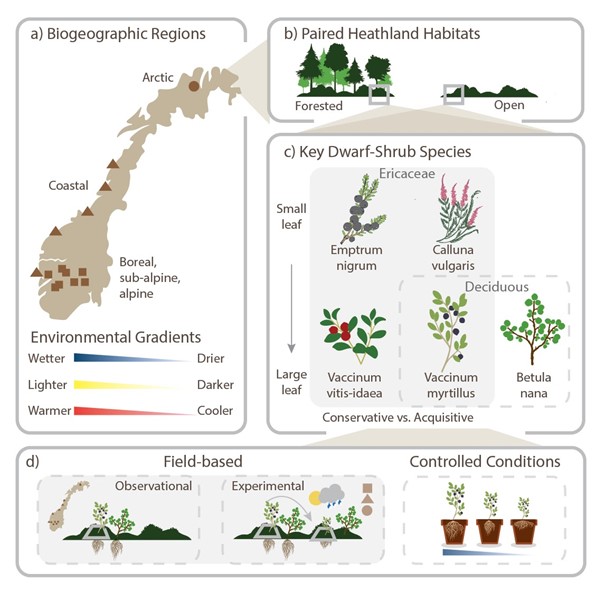 Dwarf-shrubs (Ericaceae) are a dominant plant functional group across the boreal, arctic, and alpine biomes, where they play important roles for biodiversity, ecology and ecosystem functioning. For example, dwarf-shrubs provide important food resources for grazers, pollinators, and people, they are habitat for other plants, insects, rodents, and birds, and through interactions with belowground fungal networks (ericoid mychorriza), they play critical roles in carbon sequestration and long-term carbon storage in soils.
Dwarf-shrubs (Ericaceae) are a dominant plant functional group across the boreal, arctic, and alpine biomes, where they play important roles for biodiversity, ecology and ecosystem functioning. For example, dwarf-shrubs provide important food resources for grazers, pollinators, and people, they are habitat for other plants, insects, rodents, and birds, and through interactions with belowground fungal networks (ericoid mychorriza), they play critical roles in carbon sequestration and long-term carbon storage in soils.
Despite their broad climatic and geographic ranges and dominant roles across boreal, arctic, and alpine vegetation zones, dwarf-shrub can be quite sensitive to climate changes and climate variability, as shown by their key roles in 'arctic greening' and 'arctic browning' events. This suggests that dwarf-shrubs may play a critical role in both the responses and the feedbacks between terrestrial ecosystems and the climate system.
DURIN will explore the role of dwarf-shrubs in climate responses and feedbacks across biomes and habitats, integrating plant physiology, ecology, ecosystem, and climate science. Using distributed observational systems, field experiments, and growth chamber studies; we will obtain fundamental knowledge on how climate change directly and indirectly affects this important plant functional group, and it’s ecosystem functions and services. This improved process understanding will be integrated in land surface and earth system models to understand the role and contribution of dwarf-shrubs in the feedbacks from terrestrial vegetation to the climate system.
Research objectives
The primary objective of the DURIN project is to provide critical new knowledge about an important but underrepresented plant functional type in climate-biosphere science; the dwarf-shrubs of the boreal, alpine, and arctic regions, and simultaneously provide a worked example of an integrated climate response-feedback research workflow. To that end, the secondary objectives are to:
- Examine variation in dwarf-shrubs physiological and growth responses to climate, and their impacts on microclimate (WP1);
- Map important species interactions, focusing on ericoid mycorrhizae (ErM) and quantifying key roles in dwarf-shrub carbon dynamics (WP2);
- Assess how environmental factors and vegetation characteristics impact ecosystem functioning and carbon dynamics (WP3);
- Use DURIN WP0-3 outcomes to parameterize dwarf-shrubs as a new plant functional type within a terrestrial ecosystem model (WP4);
- Create optimized data workflows using transparent, reproducible Open Science practices (WP5).
DURIN is realized through six work packages (hereafter WPs) focusing on coordinating the project, field and lab infrastructure and existing data (WP0); collecting and analyzing data on plant functioning (WP1), ecological interactions (WP2); ecosystem functioning (WP3); ecosystem feedbacks to climate (WP4); and data and analytical workflows (WP5).
WP0: Project coordination, field and lab infrastructure, and cross-WPs data (Vandvik, Egelkraut, all)
WP0 will lead, coordinate and manage the DURIN project, facilitate communication and collaboration (see section 3.1), and manage resources and infrastructure across WPs and in collaboration with external partners. The latter is critical, as DURIN builds from data and infrastructure (field sites, experiments, model platforms) of several previous and current projects (EMERALD, SeedClim, LandPress, FEEDBACK). Key infrastructures include observational systems and experiments (and associated general data), from which specific response variables will be sampled in WPs 1-3. All experiments will be set up and run using best-practice community protocols. WP5 coordinates data workflows.
WP1: Physiology and functional biology (Michaletz, Vollsnes, Geange)
WP1 will examine how different dwarf-shrubs vary in their physiological and growth responses to climate (Q1, Q3), and their impacts on microclimate (Q2). Using field and controlled environment experiments, WP1 will identify response- and effect traits and the influence of biotic interactions (WP2) on different facets of ecosystem carbon cycling (WP3), and inform analyses of feedbacks to climate (WP4). WP1 will focus on the controlled-climate experiments to establish causal relationships, which will be augmented with measurements in the field experiments and selected observational system sites.
WP2: Species interactions (Kauserud, Velle, Kirkhus)
In the assessment of species interactions, we will focus on ericoid mycorrhizae (ErM) and quantify their key role in dwarf-shrub carbon, nutrient, and water cycling. A first necessary step is to map the diversity and distribution of these organisms before we go into more specific and experimental studies of plant-mycorrhizal interactions and their climate relations. In addition, our wide environmental gradients are well-suited for broad-scale assessment of a range of interactions and ecosystem services (e.g., pollination, grazing, berry production). To expand DURINs scope, we will explore opportunities offered by collaboration with other projects and offering MSc projects.
WP3: Ecosystem functioning (Althuizen, Enquist, Birkeli)
WP3 will use the dwarf-shrub field and controlled-environment experiments to study the impact of climate and open vs. forested environment, and variation in plant functional traits and ErM association, on ecosystem functioning, focusing on carbon (C stocks and dynamics, growth, and decomposition). The goal is to identify response- and effect traits and the influence of biotic interactions on different facets of ecosystem carbon cycling, and inform analyses of feedbacks to climate (WP4).
WP4: Climate feedbacks: The CLM-FATES platform (Tang, Geange, PostDoc TBD)
In WP4 we take a terrestrial ecosystem modelling perspective, linking our insights and data from WP0-3 in order to parameterize and test a new dwarf-shrub plant functional type (PFT), and integrate it into the CLM-FATES model. We will run benchmark models against field observations at site level, and conduct model experiments exploring the role of dwarf-shrubs in both biochemical and biophysical climate feedbacks at regional and global scales.
WP5: Open Science (OS) and reproducible cross-disciplinary framework (Halbritter, Telford)
Effective realization of our project outcomes will require effective handling and integration of big, diverse, and interrelated data across different disciplines, knowledge domains, and spatial and temporal scales. To facilitate efficient and flexible data and analytical workflows, we will build custom-made pipelines for best-practice transparent and reproducible workflows and data management, following OS and FAIR (Findable, Accessible, Interoperable, Reusable) principles.
- Vigdis Vandvik, University of Bergen
- Håvard Kauserud, University of Oslo
- Sonya Geange, University of Bergen
- Inge Althuizen, NORCE Research (Miljø/Klima Vestland)
- Kristine Birkeli, University of Bergen
- Mika Kirkhus, University of Bergen
- Torhild Kvingedal, Lyngheisenteret
- Sean Michaeletz, University of British Columbia
- Brian Enquist, University of Arizona
- Liv Guri Velle, Møreforskning
- Aud Halbritter, University of Bergen
- Richard Telford, University of Bergen
- Dagmar Egelkraut, University of Bergen
- Hui Tang, University of Oslo
- Ane Vollsnes, University of Oslo
- Ella Thoen, University of Oslo
- Siri Haugum, Lyngheisenteret
- Rosie Fisher, CICERO

